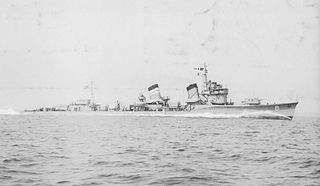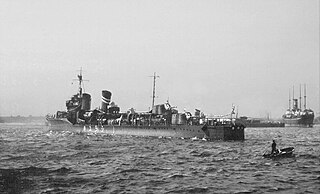Second World War
Thanet was on the China Station, deployed with the Local Destroyer Flotilla at Hong Kong on the outbreak of the Second World War on 3 September 1939. [1] Her initial duties involved carrying out patrols and intercepting German shipping, and in October she was nominated to be converted for use as a minelayer. Work began at the naval dockyard in Hong Kong on 18 October, and she was able to participate in the laying of a defensive minefield in Lantau Channel between 21 and 27 October, the following day reverting to her anti-submarine role. [1]
The rest of the year and all of 1940 was spent carrying out similar duties, deploying out of Hong Kong to protect trade and patrol in search of enemy vessels. [1] The threat of the Japanese entry to the war in December 1941 led to negotiations on 6 December between the British commander in the area, Admiral Tom Phillips, and his American counterpart Admiral Thomas C. Hart. Hart agreed to send four destroyers to Singapore, USS Whipple, Alden, John D. Edwards and Edsall, while Phillips would move Thanet and her sister-ship HMS Scout to Singapore. [3]
Events were overtaken by the Japanese attack on Pearl Harbor the following day, and the Japanese assault on Hong Kong which began on 8 December, which was effectively the same day as the Pearl Harbour assault for the International Dateline placed Hong Kong twenty-four hours ahead of the USA. Thanet and Scout hurriedly evacuated the port on 8 December, just hours after the Imperial Japanese Army attack on Mainland positions began, and made their way to Singapore to join the Eastern Fleet. [4] [5] A small force consisting of the destroyer HMS Thracian, the gunboat HMS Cicala and eight motor torpedo boats remained behind to gallantly fight the Japanese. [6] On their arrival at Singapore on 13 December, Thanet and Scout carried out various escort duties. [1]
Last battle and sinking
On 26 January 1942 Malaya Command received intelligence that a Japanese troop convoy was approaching Endau, and attempted to attack it with nine Lockheed Hudsons of No. 1 and No. 8 Squadrons, and 12 Vickers Vildebeests. [7] The attack went badly, losing five Vildebeests, and was unable to inflict significant damage. The Japanese commander, Vice-Admiral Jisaburō Ozawa had received intelligence reports that two cruisers were at Singapore, and so concentrated his forces off Endau. [7] The two cruisers were in fact Thanet, and the destroyer HMAS Vampire, and following the failure of the air attacks, Malaya Command ordered them to sea to intercept the convoy. They steamed from Singapore at 4:30 pm on 26 January, carrying only three torpedoes each. [7] [8] Early in the morning of 27 January they ran into the covering force of Japanese warships, consisting of three destroyers, later joined by the Japanese cruiser Sendai. Thanet was hit in the engine room and disabled, and began to sink. [7] Vampire attempted to lay down a smoke screen but was driven off under heavy fire, and managed to escape. [7] Thanet sank with the loss of 12 men afterwards. [9] Sixty-five crewmen managed to get to the coast and arrived at Singapore, but 31 were picked up by Shirayuki and handed over to Japanese troops the next day. It is believed they were executed in retaliation for heavy Japanese losses sustained in an ambush by the Australian 2/18th Battalion which occurred at the same time as the naval battle off Endau. [10]

HMS Indomitable was a modified Illustrious-class aircraft carrier built for the Royal Navy during World War II. Originally planned to be the fourth of the class, she was redesigned to enable her to operate more aircraft, 48 instead of 36. A second hangar was added above the original, raising the flight deck by 14 feet (4.3 m), although the hangar-side armour had to be reduced to compensate. The lower hangar was made shorter than the upper hangar due to the need for extra workshops and accommodation to support the added aircraft.

HMS Kenya was a Fiji-class cruiser of the Royal Navy. The ship was named after Kenya, a British possession at the time of the ship's construction.

The sinking of Prince of Wales and Repulse was a naval engagement in World War II, as part of the war in the Pacific, that took place on 10 December 1941 in the South China Sea off the east coast of the British colonies of Malaya and the Straits Settlements, 70 miles east of Kuantan, Pahang. The Royal Navy battleship HMS Prince of Wales and battlecruiser HMS Repulse were sunk by land-based bombers and torpedo bombers of the Imperial Japanese Navy. In Japan, the engagement was referred to as the Naval Battle of Malaya.

HMS Euryalus was a Dido-class cruiser of the Royal Navy. She was laid down at Chatham Dockyard on 21 October 1937, launched on 6 June 1939, and commissioned 30 June 1941. Euryalus was the last cruiser built at the dockyard.

HMAS Vampire was a V-class destroyer of the Royal Navy (RN) and Royal Australian Navy (RAN). Launched in 1917 as HMS Wallace, the ship was renamed and commissioned into the RN later that year. Vampire was lent to the RAN in 1933, and operated as a depot tender until just before World War II. Reactivated for war service, the destroyer served in the Mediterranean as part of the Scrap Iron Flotilla, and was escorting the British warships HMS Prince of Wales and HMS Repulse during their loss to Japanese aircraft in the South China Sea in December 1941. Vampire was sunk on 9 April 1942 by Japanese aircraft while sailing with the aircraft carrier HMS Hermes from Trincomalee.

Asagiri was the thirteenth of twenty-four Fubuki-class destroyers, built for the Imperial Japanese Navy following World War I. When introduced into service, these ships were the most powerful destroyers in the world. They served as first-line destroyers through the 1930s, and remained formidable weapons systems well into the Pacific War.

Fubuki was the lead ship of twenty-four Fubuki-class destroyers, built for the Imperial Japanese Navy following World War I. When introduced into service, these ships were the most powerful destroyers in the world. They served as first-line destroyers through the 1930s, and remained formidable weapons systems well into the Pacific War. Fubuki was a veteran of many of the major battles of the first year of the war, and was sunk in Ironbottom Sound during the Battle of Cape Esperance in World War II.

HMS Electra was a one of nine E-class destroyers built for the Royal Navy during the 1930s. Sunk in the Battle of the Java Sea, Electra was a witness to many naval battles, including the Battle of the Denmark Strait and the sinking of Prince of Wales and Repulse. The ship's wreck was discovered in 2003 and had been badly damaged by illegal salvagers by 2016.

HMS Tenedos was an Admiralty 'S' class destroyer. Laid down on 6 December 1917, she was constructed by Hawthorn Leslie of Tyne, and was completed in 1918. She was commissioned in 1919 and served throughout the interwar period.

Sendai was a Sendai-class light cruiser in the Imperial Japanese Navy. She was named after the Sendai River in southern Kyūshū. Sendai was the lead ship of the three vessels completed in her class of light cruisers, and like other vessels of her class, she was intended for use as the flagship of a destroyer flotilla.

Shirayuki was the second of twenty-four Fubuki-class destroyers, built for the Imperial Japanese Navy following World War I. When introduced into service, these ships were the most powerful destroyers in the world. They served as first-line destroyers through the 1930s, and remained formidable weapons systems well into the Pacific War. Shirayuki was sunk in the Battle of the Bismarck Sea on 3 March 1943 while under attack by American and Australian aircraft.

Yūgiri was the fourteenth of twenty-four Fubuki-class destroyers, built for the Imperial Japanese Navy following World War I. When introduced into service, these ships were the most powerful destroyers in the world. They served as first-line destroyers through the 1930s, and remained formidable weapons systems well into the Pacific War.
No 36 Squadron of the Royal Flying Corps was formed at Cramlington in 1916 and was disbanded for the last time in 1975.

The S class was a class of 67 destroyers ordered for the Royal Navy in 1917 under the 11th and 12th Emergency War Programmes. They saw active service in the last months of the First World War and in the Russian and Irish Civil Wars during the early 1920s. Most were relegated to the reserve by the mid-1920s and subsequently scrapped under the terms of the London Naval Treaty. Eleven survivors saw much action during the Second World War.

The Battle off Endau was a Second World War battle that took place off Endau town on 26–27 January 1942. Part of the Battle of Malaya, it was the first notable naval engagement since the sinking of the battleship Prince of Wales and the battlecruiser Repulse on 10 December 1941, and the last effort by the Royal Navy to intercept Japanese convoy shipping around the Malay Peninsula.

HMS Thracian was an S-class destroyer built for the Royal Navy during the First World War.

HMS Wishart (D67) was a Modified W-class destroyer of the British Royal Navy that saw service in World War II. She spent most of her wartime career based at Gibraltar, engaged in convoy defence, but also served in various naval and military operations in the Mediterranean Sea.

HMS Grimsby was a sloop of the British Royal Navy, the lead ship of her class. Grimsby was built in the 1930s, entering service in 1934. Serving most of her pre-war service at Hong Kong, Grimsby was deployed on convoy escort duties along the East coast of the Britain and in the Mediterranean Sea during the Second World War, and was sunk by dive bombers off Tobruk on 25 May 1941.
Commander William Thomas Alldis Moran was an officer of the Royal Australian Navy during the Second World War. Moran went down with HMAS Vampire, when it was sunk by Japanese aircraft off Ceylon in 1942.

HMS Falmouth was a Shoreham-class sloop of the British Royal Navy. Falmouth was built at Devonport Dockyard in 1931–1932. The ship was used as a despatch vessel on the China Station in the 1930s, but the Second World War resulted in her being rearmed, and used for escort duties. From 1952, Falmouth was used as a stationary drillship until she was scrapped in 1968.
















